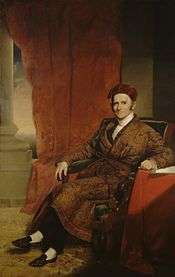Amos Lawrence
| Amos Lawrence | |
|---|---|
 | |
| Born |
April 22, 1786 Groton, Massachusetts |
| Died |
December 31, 1852 (aged 66) Boston, Massachusetts |
| Occupation | merchant, investor, philanthropist |
| Known for | Helping to establish Lawrence, Massachusetts and charitable donations |
| Net worth | $8,100,000 (upon his death) |
Amos Lawrence (22 April 1786, Groton, Massachusetts – 31 December 1852, Boston, Massachusetts) was an American merchant and philanthropist.
Biography
He was the son of Samuel Lawrence, a Revolutionary War officer, and one of the founders of Groton Academy (now Lawrence Academy at Groton), where Amos was educated. Samuel was in turn descended from John Lawrence of Wissett in Suffolk, England, who was one of the first settlers of Groton.
In 1799, Amos Lawrence became a clerk at a country store in Dunstable, Massachusetts and a few months afterward was promoted to a variety store in Groton run by a Mr. Brazer. After the completion of his apprenticeship, in April 1807, Amos went to Boston with $20 of his savings. His employers there failed. Amos was appointed by the creditors to settle the firm's accounts, and after doing that to their satisfaction he rented a shop on Cornhill and founded a dry-goods establishment on his own account in December. In 1808, his brother Abbott entered his employ as chief clerk, and in 1814 became a partner in the firm, now called A. & A. Lawrence and later A. & A. Lawrence and Co. The firm continued until Amos's death and became the greatest wholesale mercantile house in the United States. It was successful even in the hard times of 1812-1815, and afterwards engaged particularly in selling woolen and cotton goods on commission.
The firm did much for the establishment of the cotton textile industry in New England. In 1830, it came to the aid of financially distressed mills of Lowell, Massachusetts. In that year, the Suffolk, Tremont and Lawrence companies were established in Lowell, and Luther Lawrence, the eldest brother, represented the firm's interests there. In 1845-1847, the firm established and built up Lawrence, Massachusetts, named in honour of Abbott Lawrence, who was a director of the Essex Company, which controlled the water power of Lawrence, and afterwards was president of the Atlantic Cotton Mills and Pacific Mills there.
In 1831 when his health failed, Amos Lawrence retired from active involvement in the firm, where thereafter Abbott Lawrence was the head. The later years of Amos's life were spent mostly in furthering various philanthropic enterprises. According to his records, from 1829 until his death, Amos Lawrence gave over $639,000 (in 1840s dollars) to charitable causes. In 1842, he decided not to allow his property to increase any further, and in the last eleven years of his life he spent in charity at least $525,000. To Williams College, he gave nearly $40,000; to Groton Academy, which later changed its name to Lawrence Academy to honor both Amos and his brother, William Lawrence, he gave over $20,000; to Wabash College, Kenyon College, and the theological seminary at Bangor, Maine, he also gave sizable sums.
His private donations were numerous, requiring several rooms in his house to coordinate them. Among other things, Amos Lawrence donated libraries to academic institutions, established a children's hospital in Boston, and gave $10,000 for the completion of the Bunker Hill Monument (Lawrence's father had fought at the Battle of Bunker Hill). He gave to many good causes on a smaller scale, taking especial delight in occasionally giving books from a bundle in his sleigh or carriage as he drove.
Upon his death in 1852, his fortune was estimated at $8,100,000—roughly $231 million in today's dollars.
Family
The family firm, with Lawrence's brother Abbott Lawrence at its head, founded Lawrence, Massachusetts. Amos's son, Amos Adams Lawrence, founded the University of Kansas in Lawrence, Kansas, was responsible for the founding of Lawrence, Kansas (thus its name) through his work with the New England Emigrant Aid Company, and also helped found Lawrence University in Appleton, Wisconsin. His grandson, Bishop William Lawrence, was the longtime Episcopal bishop of Massachusetts.
Further reading
- Thayer, William Makepeace (1857). The Poor Boy and Merchant Prince, Or Elements of Success Drawn From the Life and Character of the Late Amos Lawrence. Boston: Gould and Lincoln. OCLC 567691.
- Swansburg, John (29 September 2014). "The Self-Made Man". Amos Lawrence: The Incorruptible Merchant. Slate.
References
 Beach, Chandler B., ed. (1914). "Lawrence, Amos". The New Student's Reference Work. Chicago: F. E. Compton and Co.
Beach, Chandler B., ed. (1914). "Lawrence, Amos". The New Student's Reference Work. Chicago: F. E. Compton and Co. Chisholm, Hugh, ed. (1911). "Lawrence, Amos". Encyclopædia Britannica (11th ed.). Cambridge University Press.
Chisholm, Hugh, ed. (1911). "Lawrence, Amos". Encyclopædia Britannica (11th ed.). Cambridge University Press.- Hunt, Freeman (1858), "Amos Lawrence", Lives of American Merchants, 2, pp. 223–330
- Lawrence, William R. (1855), Extracts from the Diary and Correspondence of the late Amos Lawrence, Boston: Gould and Lincoln
 Wilson, James Grant; Fiske, John, eds. (1892). "Lawrence, Amos". Appletons' Cyclopædia of American Biography. New York: D. Appleton. This source gives his fortune as $1,000,000 at his death.
Wilson, James Grant; Fiske, John, eds. (1892). "Lawrence, Amos". Appletons' Cyclopædia of American Biography. New York: D. Appleton. This source gives his fortune as $1,000,000 at his death. Gilman, D. C.; Thurston, H. T.; Colby, F. M., eds. (1905). "Lawrence, Amos". New International Encyclopedia (1st ed.). New York: Dodd, Mead.
Gilman, D. C.; Thurston, H. T.; Colby, F. M., eds. (1905). "Lawrence, Amos". New International Encyclopedia (1st ed.). New York: Dodd, Mead. Rines, George Edwin, ed. (1920). "Lawrence, Amos". Encyclopedia Americana.
Rines, George Edwin, ed. (1920). "Lawrence, Amos". Encyclopedia Americana.